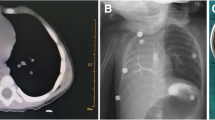Abstract
Background
Communicating bronchopulmonary foregut malformation is a rare anomaly characterized by a patent congenital communication between the esophagus or stomach and an isolated portion of the respiratory system. An esophagogram is taken as the gold standard for diagnosis. Compared with esophagography, computed tomography (CT) is more widely used and easily obtained, but CT findings have been described as nonspecific.
Purpose
To describe CT findings in 18 patients with communicating bronchopulmonary foregut malformation to assist with early diagnosis.
Material and methods
A retrospective review of 18 patients who had proven communicating bronchopulmonary foregut malformation between January 2006 and December 2021 was conducted. For each patient, the medical records, including demographics, clinical manifestations, upper gastrointestinal radiography, magnetic resonance imaging and CT findings, were reviewed.
Results
Among the 18 patients, there were 8 males. The right to left ratio was 3.5:1. An entire lung was involved in 10 patients, a lobe or a segment was involved in 7 patients and an ectopic lesion was located in the right neck in 1 patient. The isolated lung may arise from the upper esophagus, mid-esophagus, lower esophagus or stomach, which were detected in 1, 3, 13, and 1 patient, respectively. On chest CT, an extra bronchus which did not arise from the trachea was detected in 14 patients. Contrast-enhanced chest CT was performed in 17 patients, the isolated lung receiving its blood supply from the pulmonary artery in 13 patients, the systemic artery in 11 patients and both pulmonary and systemic arteries in 7 patients.
Conclusions
The presence of an extra bronchus, which does not arise from the trachea, highly suggests the diagnosis of communicating bronchopulmonary foregut malformation. Contrast-enhanced chest CT can provide accurate information regarding the airways, lung parenchyma and vascular structures that is useful to plan surgery.







Similar content being viewed by others
References
Srikanth MS, Ford EG, Stanley P, Mahour GH (1992) Communicating bronchopulmonary foregut malformations: classification and embryogenesis. J Pediatr Surg 27:732–736
Colleran GC, Ryan CE, Lee EY et al (2017) Computed tomography and upper gastrointestinal series findings of esophageal bronchi in infants. Pediatr Radiol 47:154–160
Yang G, Chen L, Xu C et al (2019) Congenital bronchopulmonary foregut malformation: systematic review of the literature. BMC Pediatr 19:305–311
Partridge EA, Victoria T, Coleman BG et al (2015) Prenatal diagnosis of esophageal bronchus -first report of a rare foregut malformation in utero. J Pediatr Surg 50:306–310
Kobayashi H, Miyakoshi K, Koinuma G (2019) Communicating bronchopulmonary foregut malformation: Volume change of the affected lung after birth. Pediatr Pulmonol 54:669–671
He QM, Xiao SJ, Zhu XC et al (2015) Communicating bronchopulmonary foregut malformation type IA: radiologic anatomy and clinical dilemmas. Surg Radiol Anat 37:1251–1256
Boersma D, Koot BG, van der Griendt EJ et al (2012) Congenital bronchopulmonary foregut malformation initially diagnosed as esophageal atresia type C: challenging diagnosis and treatment. J Pediatr Surg 47:e59-62
Choo JY, Hwang J, Lee JH, Lee KY (2017) Bronchopulmonary foregut malformation presenting as extralobar pulmonary sequestration associated with a bronchogenic cyst: an unusual clinical and radiological feature in an adolescent patient. J Thorac Dis 9:E632-635
Chung JH, Lim GY, Kim SY (2014) Esophageal lung diagnosed following the primary repair of esophageal atresia with tracheo-esophageal fistula in a neonate. Surg Radiol Anat 36:397–400
Murray ME, Given-Wilson RM, Christopher JA, Jeffrey IJ (1994) Bilateral communicating bronchopulmonary foregut malformations in an infant with multiple congenital anomalies. Pediatr Radiol 24:128–130
Singal AK, Kumar VR, Rao M et al (2006) Bilateral communicating bronchopulmonary foregut malformations in a child. Ann Thorac Surg 82:330–332
Takamizawa S, Yoshizawa K, Machida M et al (2012) Successful tracheobronchial reconstruction of communicating bronchopulmonary foregut malformation and long segment congenital tracheal stenosis: a case report. J Pediatr Surg 47:E41-46
Alsaadi A, Alsufiani HA, Allugmani MD et al (2018) Esophageal lung with rare associated vascular and anorectal malformations. Radiol Case Rep 13:444–448
Verma A, Mohan S, Kathuria M, Baijal SS (2008) Esophageal bronchus: case report and review of the literature. Acta Radiol 49:138–141
Harumatsu T, Kaji T, Nagano A et al (2021) Successful thoracoscopic treatment for tracheoesophageal fistula and esophageal atresia of communicating bronchopulmonary foregut malformation group IB with dextrocardia: a case report of VACTERL association. Surg Case Rep 7:11–15
Lee EY, Siegel MJ, Sierra LM, Foglia RP (2004) Evaluation of angioarchitecture of pulmonary sequestration in pediatric patients using MDCT angiography. Am J Roentgenol 183:183–188
Lambert V, Signal-Cinqualbre A, Belli E et al (2005) Preoperative and postoperative evaluation of airway compression in pediatric patients with 3-dimensional multislice computed tomographic scanning: effect on surgical management. J Thorac Cardiovasc Surg 129:1111–1118
Tsugawa J, Tsugawa C, Satoh S et al (2005) Communicating bronchopulmonary foregut malformation: particular emphasis on concomitant congenital tracheobronchial stenosis. Pediatr Surg Int 21:932–935
Langston C (2003) New concepts in the pathology of congenital lung malformations. Semin Pediatr Surg 12:17–37
Riedlinger WFJ, Vargas SO, Jennings RW et al (2006) Bronchial atresia is common to extralobar sequestration, intralobar sequestration, congenital cystic adenomatoid malformation, and lobar emphysema. Pediatr Dev Pathol 9:361–373
Lee EY, Dorkin H, Vargas SO (2011) Congenital pulmonary malformations in pediatric patients: review and update on etiology, classification, and imaging findings. Radiol Clin North Am 49:921–948
Funding
The Special Fund of The Pediatric Medical Coordinated Development Center of Beijing Municipal Administration, No.: XTCX201814. Beijing Hospitals Authority’s Ascent Plan, Code: DFL20221002.
Author information
Authors and Affiliations
Corresponding author
Ethics declarations
Conflicts of interest
None
Additional information
Publisher's Note
Springer Nature remains neutral with regard to jurisdictional claims in published maps and institutional affiliations.
Rights and permissions
Springer Nature or its licensor (e.g. a society or other partner) holds exclusive rights to this article under a publishing agreement with the author(s) or other rightsholder(s); author self-archiving of the accepted manuscript version of this article is solely governed by the terms of such publishing agreement and applicable law.
About this article
Cite this article
Han, Z., Yu, T., Huang, J. et al. Computed tomography findings of communicating bronchopulmonary foregut malformation: a retrospective study of 18 patients. Pediatr Radiol 53, 1063–1075 (2023). https://doi.org/10.1007/s00247-023-05610-z
Received:
Revised:
Accepted:
Published:
Issue Date:
DOI: https://doi.org/10.1007/s00247-023-05610-z




